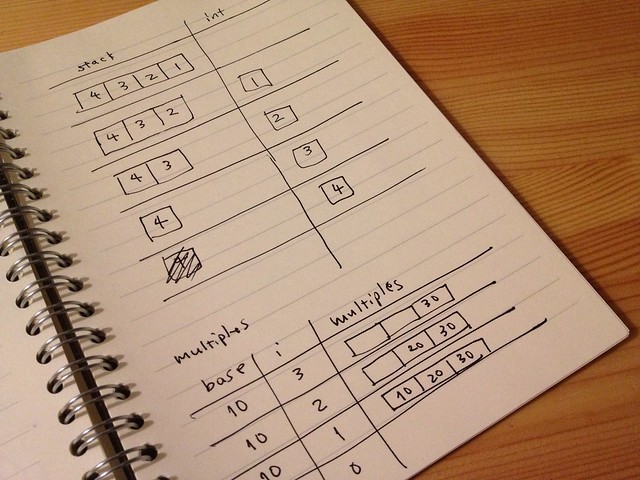Recursion in JavaScript
2012-11-12 MondayCodecademy で Recursion in JavaScript が終わった!手ごわかった!
このコースの前に、Review of Object-Oriented Programming っていうコースがあり、それにくっついてる演習が Project: Cash Register Part II で、その中にこんなのがでてきたのです。
var change = 0;
function howManyQuarters(howMuchMoney) {
//fill this in
if (howMuchMoney < 0.25){
change = howMuchMoney;
return 0;
} else {
return 1 + howManyQuarters(howMuchMoney - 0.25);
}
}
change = 0.99;
console.log ("Pay out " + howManyQuarters(change) + " quarters");
console.log ("And you'll have " + change * 100 + " pennies left over"); なにこれ。なんで howManyQuarters がぐるぐるしてるのかさっぱりわかんない!
(後から考えるとそもそも howManyQuarters(howMuchMoney - 0.25) これが function に見えてなかった)
と嫌になりかけてたところ、ん、Section のタイトルに Recursing on a number ってあるよね。で次のコース、Recursion in JavaScript だよね。そっち先にやったらよさそうだよね。
Recursion やったるで!Section 1 では function と loop のおさらい。Section 2 でこれ。
function factorial(n) {
// Termination condition to prevent infinite recursion
if (n < 0) {
console.log("Can't make a factorial from a negative number.");
return;
}
// Base case
if (n === 0) {
return 1;
}
// What's wrong with this picture? Why won't this recursion work?
return n * factorial(n - 1);
}
factorial(5);Base case と Termination condition が何のためにあるのかはわかったけど、
return n * factorial(n - 1); これ……わからん… factorial(n) の中なのに factorial(n - 1) って?ううう。
すみません先輩わかりませんたすけてください。
図解するとこういうことだった。Recursion はマトリョーシカだった。

もしくは、階段を降りていっていちばん下で何か拾い、またいちばん上まで戻ってきたら何かが完成してた!とか。
It is a visual guide to how values are stored in the stack.
1.factorial(3) {
return 3 * factorial(2);
2. factorial(2) {
return 2 * factorial(1);
3. factorial(1) {
return 1 * factorial(0);
4. factorial(0) {
A= return 1;
};
5. factorial(1) {
B= return 1; // 1 * 1
};
6. factorial(2) {
C= return 2; // 2 * 1
};
7.factorial(3) {
D= return 6; // 3 * 2
};その説明は以下。
You may be wondering where the computer is storing the values returned by each function call in our recursion. That is a very good question, and it has an answer!
When you run a program, the data that is produced within that program (variables, function calls, etc.) are stored in the stack, which you can think of as a temporary storage device for the computer.
Every time a function is called within a program, the returned value of that function is stored in the stack.
data が stack に store されるの…うん… よくわからないので Hint を見る。
This is boring, I know. Let’s get out of here. It gets better. Just press Run.
OK, got it! Run.
次にわかんなくなったのはここ。int から順番にカウントダウンしていったのを stack という array に入れといて、それをひとつずつ掛ける function.
var stack = [];
function countDown(int) {
stack.push(int);
if (int === 1) {
return 1;
}
return countDown(int - 1);
}
// [7, 6, 5, 4, 3, 2, 1]
// ここまでは大丈夫。
function multiplyEach() {
// Remove the last value of the stack
// and assign it to the variable int
int = stack.pop();
x = stack.length;
// Base case
if (x === 0) {
return int;
}
// ここまでも大丈夫。でも以下の Recursive case に何書けばいいのかわかんなかった。
// Recursive case
else {
return int * multiplyEach();
}
}
// Call the function countDown(7)
countDown(7);
// And then print out the value returned by multiplyEach()
console.log(multiplyEach());表に書くことを学んだ。書いてみると、あー、そういうことかー!ってわかるのね。
プログラミングで紙なんて使わないと思ってたけど、紙とペン、だいじだった。

忘れないうちに Project: Recursive Functions もやっつけたい。

Author
Yuko Honda Morita (yukop) : yukop.com
飯能→東京→シリコンバレー。夫と猫2匹と暮らしてます。作ったり学んだり踊ったりするのが好き。
Born in Japan, living in California with my husband and two cats. "A bit of a geek and a bit of a geek fan and a bit of an artist." ->
Latest Posts
Japanese
- 2016-02-20 » フロントバンパーの外し方メモ - SUBARU XV Crosstrek 2014
- 2016-01-19 » Singular they
- 2015-12-21 » San Joaquin River NWR
- 2015-12-20 » San Luis NWR
- 2015-11-22 » EAD(労働許可証)更新 その1
- 2015-11-08 » Burrowing Owl アナホリフクロウ
- 2015-10-31 » Tire Pressure Warning
English
- 2014-10-18 » Halloween Decorations
- 2014-08-01 » Cat Parasite
- 2014-07-29 » How to Make Dumplings From Scratch
- 2014-07-25 » Moving to an Unfamiliar Land That Speaks a Foreign Language
- 2014-07-23 » Going to See a Dentist
- 2014-07-22 » Agent Cooper's Favorite Cherry Pie
- 2014-07-19 » It's Nice Living with Two Kittens